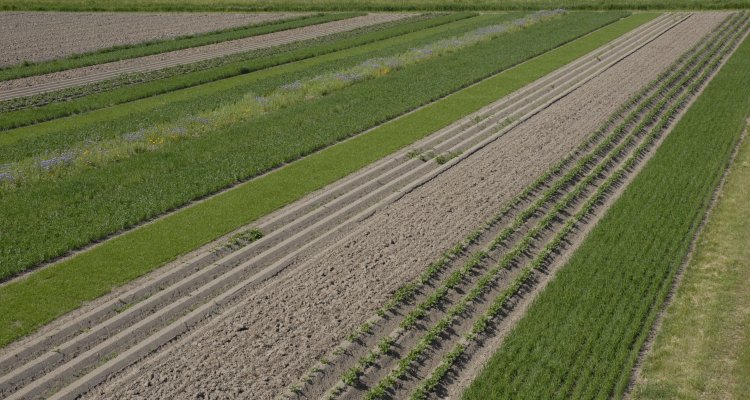
Strip cultivation of six different crops for more biodiversity
Cultivating six different crops on one field alongside each other. This seems an impossible task. And yet Applied Plant Research is testing such a system. This is how they wish to develop a farming system that suffers little from pests, diseases, or extreme weather conditions.
Reversing the trend. This is challenging task set by the scientists. Agricultural fields are getting ever larger because this is how farmers can decrease the cost price of their produce. And it becomes easier to meet the requirements of the large customers that demand large amounts of uniform products.
Agriculture became too vulnerable
The scientists are having doubts about this trend. Large uniform areas of one crop make the system vulnerable. Only one pest insect or fungus needs to ‘land’ and the whole field will be infested unless measures are rapidly taken. This is caused by the fact that natural enemies find it difficult to survive on such a large field: there is too little (alternative) food and there is no shelter.
The scientists are searching for a solution by creating more diversity in a field. This offers beneficial organisms sufficient food and shelter throughout the year. And this in turn makes life difficult for harmful organisms, resulting in these finding it difficult to cause damage to the crops.
The scientists are testing strip cultivation as a means to increase this biodiversity in a field. On 3-metre wide strips they are alternately growing six different crops alongside each other. In doing so they make the best possible use of permanent driving strips, only resulting in local compaction of the soil. This favours soil life and thus the crop.
Diverse soil life
Diversity of life in and on the soil is benefiting from these measures. Throughout the year soil life is benefiting from the shelter opportunities and food. After one crop is harvested, another crop is left. And the soil is never bare for a long time because a green manure crop is grown immediately after harvest.
This results in a ‘robust suppressive farming system’. A new balance is reached soon after the system would be disturbed without endangering agricultural production and without the grower needing to take measures: the system itself can absorb the changes. It does, e.g., ‘control’ pests and diseases before these can cause damage and gives a better protection against extreme weather conditions such drought or heavy precipitation.
Economically profitable
The scientists are now facing the question whether the system can be made economically profitable. They expect modern techniques to help, such as GPS-based precision techniques, ICT, and advanced sensors. This makes it easy to combine crop care and harvesting operations of the strips of one crop into a single operation.
The scientist also wish to find out the minimum width of the strips, e.g., to enable terrestrial insects to function properly. This means that the experiments need to be kept running for a number of years. This research is carried out on a commercial farm and on PPO’s experimental farm in Lelystad.